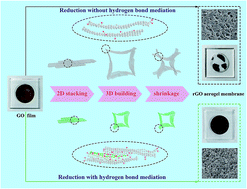Reduced graphene oxide aerogel membranes fabricated through hydrogen bond mediation for highly efficient oil/water separation†
Abstract
Reduced graphene oxide aerogels (rGOAs) are broadly applied in energy and environmentally relevant fields. However, rGOAs have been rarely reported for fabrication of separation membranes. In this study, we demonstrate the fabrication of reduced graphene oxide aerogel membranes (rGOAMs) via reduction-induced self-assembly of rGO through hydrogen bond mediation. When using polyethylene glycol (PEG) as the mediator, the PEG–rGO hydrogen bonding interactions partly replace interlayer π–π and hydrophobic interactions during reduction, decreasing the rGO laminates’ size in 2D stacking and alleviating the structural shrinkage of rGOA networks. The tight correlation between membrane pore size and porosity was broken, leading to rGOAMs with tunable pore sizes (0.62 to 0.33 μm) and high porosity (∼95%). The resultant rGOAMs can effectively reject oil-in-water emulsions with different sizes and exhibit ultrahigh water fluxes (up to 4890 L m−2 h−1) under 0.10 bar as well as a persistent anti-oil-fouling performance up to 6 cycles. Three other kinds of hydrophilic polymers including polyvinyl alcohol, polyglycine and polyvinyl pyrrolidone are also utilized as mediators to elucidate the structure–performance relationship. Molecular simulation reveals that the pore size of rGOAMs is strongly affected by the hydrogen bond interaction intensity of the rGO–polymer and polymer size.



 Please wait while we load your content...
Please wait while we load your content...